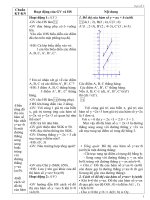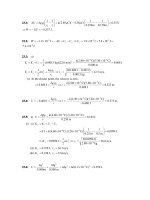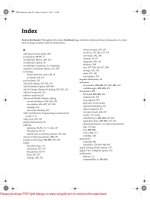20200212 sitrep 23 ncov
Bạn đang xem bản rút gọn của tài liệu. Xem và tải ngay bản đầy đủ của tài liệu tại đây (1013.14 KB, 7 trang )
Coronavirus disease 2019 (COVID-19)
Situation Report – 23
Data as reported by 12 February 2020*
HIGHLIGHTS
SITUATION IN NUMBERS
total and new cases in last 24
hours
•
No new countries reported cases of COVID-19 in the past 24 hours.
•
WHO has published key considerations for repatriation and quarantine of
travellers in relation to COVID-19. More information can be found here.
Globally
45 171 confirmed (2068 new)
•
The UN activated a Crisis Management Team (CMT) on the COVID-19
outbreak, to be led by WHO. The WHO Director-General nominated Dr Mike
Ryan, Executive Director of WHO Health Emergencies Programme as the Crisis
Manager. The CMT brings together WHO, OCHA, IMO (International Maritime
Organization), UNICEF, ICAO, WFP, FAO, the World Bank and several
departments of the UN Secretariat. It held its first meeting yesterday via
teleconference. This mechanism will help WHO focus on the health response
while the other agencies will bring their expertise to bear on the wider social,
economic and developmental implications of the outbreak. Additional
members will be included depending on the evolution of the outbreak and its
impact globally.
China
44 730 confirmed (2022 new)
8204 severe (871 new)
1114 deaths (97 new)
•
Outside of China
441 confirmed (46 new)
24 countries
1 death
WHO RISK ASSESSMENT
WHO has prepared a list of Q&A on infection prevention and control for
health care workers caring for patients with suspected or confirmed 2019nCoV
China
Regional Level
Global Level
Figure 1. Countries, territories or areas with reported confirmed cases of COVID-19, 12 February 2020
*The situation report includes information provided by national authorities as of 10 AM Central European Time
Very High
High
High
TECHNICAL FOCUS: Internationally exported COVID-19 cases
Excluding China, there are 24 countries reporting cases of COVID-19. Among these 24 countries, 23 report cases with
an exposure in China. In addition, 11 of these 23 countries report cases attributed to local transmission inside the
reporting country. Four of the 24 countries report cases where likely exposure occurred outside the reporting
country and outside of China. Among these four reporting countries the most likely countries where exposure
occurred were France, Germany, Japan and Singapore (see map below). All transmissions occurred within known
defined clusters.
SURVEILLANCE
Table 1. Confirmed cases of COVID-19 acute respiratory disease reported by provinces, regions and cities in China,
12 February 2020
Province/Region/City1
Hubei
Guangdong
Zhejiang
Henan
Hunan
Anhui
Jiangxi
Jiangsu
Chongqing
Shandong
Sichuan
Heilongjiang
Beijing
Shanghai
Fujian
Hebei
Shaanxi
Guangxi
Yunnan
Hainan
Shanxi
Guizhou
Liaoning
Tianjin
Gansu
Jilin
Inner Mongolia
Xinjiang
Ningxia
Hong Kong SAR
Qinghai
Taipei and environs
Macao SAR
Xizang
Total
1
Population (in 10,000s)
Confirmed Cases
5917
11346
5737
9605
6899
6324
4648
8051
3102
10047
8341
3773
2154
2424
3941
7556
3864
4926
4830
934
3718
3600
4359
1560
2637
2704
2534
2487
688
745
603
2359
66
344
142823
33366
1219
1131
1135
946
889
844
543
505
497
436
378
352
306
272
251
225
222
154
145
124
131
111
106
86
83
60
59
58
49
18
18
10
1
44730
Suspect
Cases2
11295
135
263
538
135
79
155
62
428
71
432
171
218
177
74
43
367
248
89
206
65
53
287
328
18
57
11
31
31
0
0
0
0
0
16067
China Statistical Yearbook - 2019
National Bureau of Statistics of China, 1 October 2019
2
Number of individuals under investigation for COVID-19 as of 12 Feb 2020. This category is not cumulative.
Total Deaths
1068
1
0
8
2
4
1
0
3
1
1
8
3
1
0
2
0
1
0
3
0
1
0
2
2
1
0
0
0
1
0
0
0
0
1114
Table 2. Countries, territories or areas with reported confirmed COVID-19 cases and deaths. Data as of 12
February 2020
WHO Region
Total
Total cases with Total cases with
cases with
possible or
site of
Confirmed*
travel
confirmed
transmission Total deaths
Country/Territory/Area
cases (new) history to transmission
under
(new)
China outside of China† investigation
(new)
(new)
(new)
‡
China
44 730 (2022)
1114 (97)
Singapore
Japan
Republic of Korea
Malaysia
Australia
Viet Nam
Philippines
Cambodia
Thailand
India
South-East Asia Region
Nepal
Sri Lanka
United States of
Region of the Americas America
Canada
Germany
France
The United Kingdom
Italy
European Region
Russian Federation
Spain
Belgium
Finland
Sweden
Western Pacific Region
Eastern Mediterranean
Region
United Arab Emirates
Other
International
conveyance (Japan)
47 (2)
28 (2)
28 (0)
18 (0)
15 (0)
15 (0)
3 (0)
1 (0)
33 (0)
3 (0)
1 (0)
1 (0)
22 (0)
24 (2)
13 (0)
15 (0)
15 (0)
8 (0)
2 (0)
1 (0)
23 (0)
3 (0)
1 (0)
1 (0)
25 (2)
4 (0)
12§§ (0)
3‡‡ (0)
0 (0)
7 (0)
0 (0)
0 (0)
6††† (0)
0 (0)
0 (0)
0 (0)
0 (0)
0 (0)
3 (0)
0 (0)
0 (0)
0 (0)
1 (0)
0 (0)
4 (0)
0 (0)
0 (0)
0 (0)
0 (0)
0 (0)
0 (0)
0 (0)
0 (0)
0 (0)
1 (0)
0 (0)
0 (0)
0 (0)
0 (0)
0 (0)
13 (0)
7 (0)
16 (2)
11 (0)
8 (0)
3 (0)
2 (0)
2 (0)
1 (0)
1 (0)
1 (0)
11 (0)
6 (0)
2 (0)
5 (0)
1 (0)
3 (0)
2 (0)
0 (0)
1 (0)
1 (0)
1 (0)
2 (0)
0 (0)
14 (2)
6 (0)
7*** (0)
0 (0)
0 (0)
2§ (0)
0 (0)
0 (0)
0 (0)
0 (0)
1 (0)
0 (0)
0 (0)
0 (0)
0 (0)
0 (0)
0 (0)
0 (0)
0 (0)
0 (0)
0 (0)
0 (0)
0 (0)
0 (0)
0 (0)
0 (0)
0 (0)
0 (0)
0 (0)
0 (0)
0 (0)
8 (0)
6 (0)
1 (0)
1 (0)
0 (0)
175** (40)
0 (0)
1 (1)
174 (39)
0 (0)
*Case
classifications are based on WHO case definitions for COVID-19.
of transmission is classified based on WHO analysis of available official data and may be subject to reclassification as additional data
become available.
‡Confirmed cases in China include cases confirmed in Hong Kong SAR (49 confirmed cases, 1 death), Macao SAR (10 confirmed cases) and Taipei
and environs (18 confirmed cases).
**Cases identified on a cruise ship currently in Japanese territorial waters.
§The exposure for 2 cases occurred outside of Spain.
***The exposure for 6 cases occurred outside of the United Kingdom.
§§The exposure for 3 cases occurred outside of Republic of Korea.
‡‡The exposure for 1 case occurred outside of Malaysia.
†Location
ERRATUM – Due to a typographical error, the total confirmed cases and death in China were incorrect. It has been corrected here.
Figure 2: Epidemic curve of COVID-19 cases (n=155) identified outside of China, by date of onset of symptoms and
travel history, 12 February 2020
Note for figure 2: Of the 441 cases reported outside China, 16 were detected while apparently asymptomatic. For
the remaining 425 cases, information on date of onset is available only for the 155 cases presented in the
epidemiologic curve.
Figure 3: Epidemic curve of COVID-19 cases (n=441) identified outside of China, by date of reporting and travel
history, 12 February 2020
STRATEGIC OBJECTIVES
WHO’s strategic objectives for this response are to:
•
•
•
•
•
•
Limit human-to-human transmission including reducing secondary infections among close contacts and
health care workers, preventing transmission amplification events, and preventing further international
spread from China*;
Identify, isolate and care for patients early, including providing optimized care for infected patients;
Identify and reduce transmission from the animal source;
Address crucial unknowns regarding clinical severity, extent of transmission and infection, treatment
options, and accelerate the development of diagnostics, therapeutics and vaccines;
Communicate critical risk and event information to all communities and counter misinformation;
Minimize social and economic impact through multisectoral partnerships.
*This can be achieved through a combination of public health measures, such as rapid identification, diagnosis
and management of the cases, identification and follow up of the contacts, infection prevention and control in
health care settings, implementation of health measures for travelers, awareness-raising in the population and
risk communication.
PREPAREDNESS AND RESPONSE
•
•
•
•
•
•
•
•
•
•
•
To view all technical guidance documents regarding 2019-nCoV, please go to this webpage.
WHO is working closely with International Air Transport Association (IATA) and have jointly developed a
guidance document to provide advice to cabin crew and airport workers, based on country queries. The
guidance can be found on the IATA webpage.
WHO has developed a protocol for the investigation of early cases (the “First Few X (FFX) Cases and contact
investigation protocol for 2019-novel coronavirus (2019-nCoV) infection”). The protocol is designed to gain an
early understanding of the key clinical, epidemiological and virological characteristics of the first cases of 2019nCoV infection detected in any individual country, to inform the development and updating of public health
guidance to manage cases and reduce potential spread and impact of infection.
WHO has been in regular and direct contact with Member States where cases have been reported. WHO is also
informing other countries about the situation and providing support as requested.
WHO has developed interim guidance for laboratory diagnosis, advice on the use of masks during home care and
in health care settings in the context of the novel coronavirus (2019-nCoV) outbreak, clinical management,
infection prevention and control in health care settings, home care for patients with suspected novel
coronavirus, risk communication and community engagement and Global Surveillance for human infection with
novel coronavirus (2019-nCoV).
WHO has prepared disease commodity package that includes an essential list of biomedical equipment,
medicines and supplies necessary to care for patients with 2019-nCoV.
WHO has provided recommendations to reduce risk of transmission from animals to humans.
WHO has published an updated advice for international traffic in relation to the outbreak of the novel
coronavirus 2019-nCoV.
WHO has activated of R&D blueprint to accelerate diagnostics, vaccines, and therapeutics.
WHO has developed an online course to provide general introduction to emerging respiratory viruses, including
novel coronaviruses.
WHO is providing guidance on early investigations, which are critical to carry out early in an outbreak of a new
virus. The data collected from the protocols can be used to refine recommendations for surveillance and case
definitions, to characterize the key epidemiological transmission features of 2019-nCoV, help understand spread,
severity, spectrum of disease, impact on the community and to inform operational models for implementation of
•
•
countermeasures such as case isolation, contact tracing and isolation. Several protocols are available here:
/>WHO is working with its networks of researchers and other experts to coordinate global work on surveillance,
epidemiology, modelling, diagnostics, clinical care and treatment, and other ways to identify, manage the
disease and limit onward transmission. WHO has issued interim guidance for countries, which are updated
regularly.
WHO is working with global expert networks and partnerships for laboratory, infection prevention and control,
clinical management and mathematical modelling.
RECOMMENDATIONS AND ADVICE FOR THE PUBLIC
During previous outbreaks due to other coronavirus (Middle-East Respiratory Syndrome (MERS) and Severe
Acute Respiratory Syndrome (SARS), human-to-human transmission occurred through droplets, contact and
fomites, suggesting that the transmission mode of the 2019-nCoV can be similar. The basic principles to reduce
the general risk of transmission of acute respiratory infections include the following:
•
•
•
•
•
Avoiding close contact with people suffering from acute respiratory infections.
Frequent hand-washing, especially after direct contact with ill people or their environment.
Avoiding unprotected contact with farm or wild animals.
People with symptoms of acute respiratory infection should practice cough etiquette (maintain distance, cover
coughs and sneezes with disposable tissues or clothing, and wash hands).
Within health care facilities, enhance standard infection prevention and control practices in hospitals, especially
in emergency departments.
WHO does not recommend any specific health measures for travellers. In case of symptoms suggestive of respiratory
illness either during or after travel, travellers are encouraged to seek medical attention and share their travel history
with their health care provider.









